sRGB has ever since been the primary "least common denominator" for camera-produced JPGs and regular monitors, at the same time it is one of the most limited color spaces which means that proactive limitation to this space cuts away all of the possible quality that a raw image could and most middle class cameras contain. Quality printers have long shown a wider color space in green and blue shades than sRGB and more recently high color WCG (Wide color Gamut) monitors are becoming affordable.
This red square [1] is 100% red with RGB values of 255 - 0 - 0
It is the "reddest" red that can be coded within a JPG file without any reference to a specific color space. In practice this is invariably be interpreted as "sRGB" - ONLY sRGB-Red , which is the reddest red within the very limited sRGB color space. It is by far not the reddest red that a human can perceive and experience.Adobe Lightroom takes care of this fact by transforming this 100% sRGB red into its own much wider ProPhoto color space and treats this color internally as 75% Red, 34% Green(!) and 13,7% Blue (!).
When this very picture is then being exported as an AdobeRGB JPG file, it is encoded with values 218 - 0 - 0 which reflects the fact that Adobe RGB can display and encode a much redder red than sRGB and consequently sRGB-red cannot occupy the "100%" coding value of 255 in this scale.
.
The red square below [2] is again 100% sRGB-red in an Adobe RGB JPG file encoded as 218 - 0 -0

Now two interesting effects take place.
In most cases you (the reader) will have an sRGB monitor and this red field [2] and the one above [1] should look totally identical. If they don´t and [2] looks even a bit "darker" than the first it means that your browser does not interpret the color space of the file and does not transform it correctly into your monitor sRGB space. [Firefox should do, IE, Opera and Google Chrome don´t as of now]You may download the two files (right-click->save as) and try to open them in differnent picture viewers or graphics programs. You may and will find that some programs show the files with identical looks (correct) and others like Windows Paint don´t. Some picture viewers behave differently depending on window or full screen mode.
They should always look identical - if they don´t its your software that is imperfect.
If you are in the lucky position to possess a High Color Monitor .e. one of the recent WCG [Wide Color Gamut] models like
DELL UltraSharp 2709W or U2410
EIZO FlexScan S2433W
HP 2475w or LP2480
LG Flatron W2220 or W2420
you should still see the above red fields also as identical but you will principally be able to see a truely much redder red if an Adobe RGB file ist encoded with it´s maximum values of 255 - 0 - 0. Such a color outside of the sRGB space is "out of range" for most of us which means that photos may lose a bit of detail as the color shades are "clipped" to the closest match for all regular sRGB viewers.
The following three examples can therefore ONLY be appreciated by high color WCG monitor viewers. All others will not notice any difference.
This red sqare above [3] is an EXTREME RED with 95% red, 7.1% green and 5% blue in the large ProPhoto space. It is exported with reference to "ProPhoto" and coded with 240 - 15 - 13 RGB values, which means that relative to the very large ProPhoto space this red is still not the absolute maximum reddest red ever possible, but it is close!
The next example below [4] shows this same EXTREME RED (95% ProPhoto -Red) exported as Adobe RGB JPG.
Adobe RGB does actually not contain this level of red so it is clipped to 254 - 0- 0 in Adobe RGB.
In other words the field above is "100% Adobe RGB red" the reddest red achievable in the Adobe RGB space. On a monitor cabable of Adobe RGB this should be obvious by the fact that this field [4] are much redder that the sRGB ones at the top of this post.[1] and [2]. If the monitor can even go beyond Adobe RGB then [3] will visibly be even redder than [4].
On a wide color monitor you will see and notice what you lost as [5] is downconverted to match again the extremely limited sRGB space.
Everybody else will notice no difference between [1] [4] and [5] and may even perceive [2] and [3] as somewhat more "faint" than the others although [2] is actually regular sRGB red (like [1]) and [3] is actually the reddest most glowing red field in this whole posting.
- More color is always better!
- High color monitors will become affordable and will spread widely within the coming years.
- Consequently WE ALL should stop to limit ourselves to the least common denominator and overcome the dictate of the "sRGB paradigm".
- We must begin to fill our photo archives with high color quality content.
We should be the front-line of quality producers and accept and ignore the fact that laggard sRGB viewers with erratic software setups may even critizise our photos as "faint".
It´s a chicken/egg problem - content drives the industry to improve - similar to the video/broadcast industry - everybody is now producing in HD - although the majority of viewers is still using SD-equipment.
So finally, if you are still not convinced - then switch to raw photography now or (concurrent raw/jpg) and KEEP your RAWS. Storage has become cheap and your RAWS have the capability to be exported to higher color space JPGs with minimal effort once my prediction has become an obvious reality.






No comments:
Post a Comment